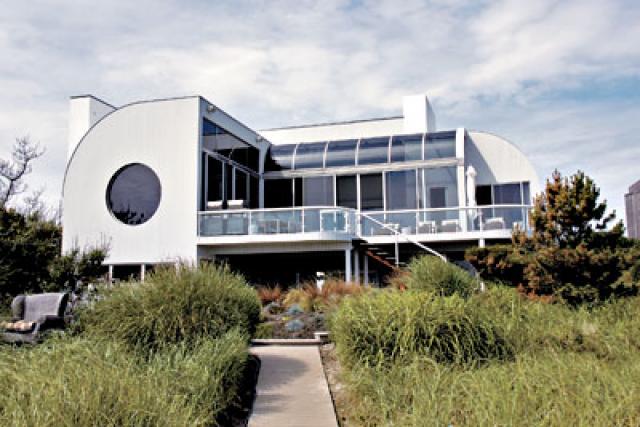Modern Curves and Portholes

A sandcastle, cruise ship, discotheque, and whitewashed house on a Greek island all come to mind, although the vernacular is mid-20th century modern. Without question, the owners have spent this summer in one of the most remarkable oceanfront houses on the South Fork. They call its design timeless. The 2,400-square-foot house has made Beach Hampton beach walkers buzz for almost 30 years, since 1986, when it reared its stucco walls, barrel-like roofs, and porthole windows, disrupting the parade of modest wood-clad buildings. It was carefully restored recently and purchased by George Gavalas, a Bridgehampton builder, and his wife, Anastasia, a family life teacher, who wanted a summer retreat for their family of five children, ages 8 to 16. “They brought it back to life,” said the East Hampton architect Bob Ortmann, a partner in the architectural firm of Zwirko and Ortmann. It was Greg Zwirko who dreamed up this imaginative structure. It began with a New York City couple, Irving and Phyllis Milstein, who had a keen taste for modern design. (They are not related to the Millstein family known for Manhattan real estate, finance, and philanthropy.) The architect Robert A. M. Stern (who is profiled in this supplement) had redone their Manhattan brownstone, but when they bought the original house on the site, they turned instead to Mr. Zwirko, whom they had met on the Amagansett beach, walking his dog. As Mr. Zwirko recently told the story, they asked if he “would like to take a crack at a modern house,” specifying that they wanted something “playful, free-flowing, and like a sandcastle.” Though he is a disciple of Alfred A. Scheffer’s traditional work, he had just designed a modern house in Montauk and undertook the creation of a house that would be unique. Local and federal regulations had changed since the first house on the dune had been built, and the architect used its grandfathered footprint to avoid moving the new one back 50 feet. Spared the severe effects of erosion, the house still sits on a high dune. With two wings extending north and south, the footprint was something like a pinwheel with a center and two blades. But as the architects experimented with a scale model, the building turned into three intersecting shapes, each forming what is called a barrel vault, with curved roof and wall like half a barrel upside down. The largest, central vault is two stories high, soaring over the center of the house and running parallel to the ocean. When the vault’s upward curve reaches the roof beam, glass panels (which are tinted to reduce heat from sunlight) curve down to full-length windows and sliding doors. The result is an uninterrupted view of sea and sky. The inspiration was the ocean, Mr. Zwirko said. The Milsteins wanted a house that says “beach,” and “the shapes you see are like waves breaking.” At both ends, the central vault joins at right angles with two half vaults, with one side of each mostly replaced by a wall of vertical glass. One vault extends back from the living room to the master bedroom and bath, ending in a massive, six-foot-diameter porthole of one-way glass with a shade for nighttime privacy. The vault at the other end of the house, which reaches toward the water, contains the kitchen and dining area and ends with a stunning view through another porthole. To maximize the view, these rooms are on the second floor, with a stairway leading from a deck to a beach path. The ground floor has three bedrooms, two with bunk beds for the younger children, two baths, and a one-car garage. (This was the mid-1980s, after all.) The bedrooms are separated by a wide breezeway under the house leading directly to the beach. “You get out of your car, walk up three steps, and right away, there’s the ocean ahead of you. You hear it; you see it. It’s magnificent,” Ms. Gavalas said. An unobtrusive sliding door on one side leads to a stairwell that passes a powder room somehow slung between the floors. When they looked for a summer house, Ms. Gavalas said, “We wanted something unusual. The railings and round windows give this a bit of the look of a cruise ship, but you’re never off the beach.” In addition to their winter house in Bridgehampton, the family has another on the island of Santorini, but, said Ms. Gavalas, “Now we don’t have to go so often.” An appealing feature, she said, is that indoors the vaults have curved flanges, accentuating a slight rainbow effect that gently suggests the proscenium of Radio City Music Hall. The curves are fitted with tiny lights made by Xanadu, the company known for its chandeliers. They, and the recessed lights in the outdoor railings give the house “a bit of a disco feel” at night, Ms. Gavalas said. Curves are elsewhere, too — in the round overhang at the entrance to the breezeway, in the railings around the deck, in the shape of the central island in the kitchen and the custom-made light fixture above it, and in the moldings that hold cove lighting in several rooms. The breaking-wave effect of the main vault is repeated in three bays that extend from the sides of the house. One, with a small window protected by shades for privacy, contains the master bathtub. Ms. Gavalas has landscaped the back of the very tight lot, replacing grass with mulch and trees and shrubs. Paths curve around the house on both sides. The Gavalases have kept their furnishings in off-white and gray, echoing the taste of the Milsteins, who were, Mr. Zwirko said, significant art collectors but favored strict black and white decor. “They had a black dog and a white cat, and when they went to the beach, Mr. Milstein wore black shirts, and she wore a black robe,” he said. “The only color in the house was their parrot.” U
